All about the reproduction of zamiokulkas at home
Potted plants always represent the decoration of any home, testifying to the skill and homeliness of the hostess. One of the most beautiful and unpretentious flowers is zamiokulkas. However, despite all its unpretentiousness, this plant requires care and attention.
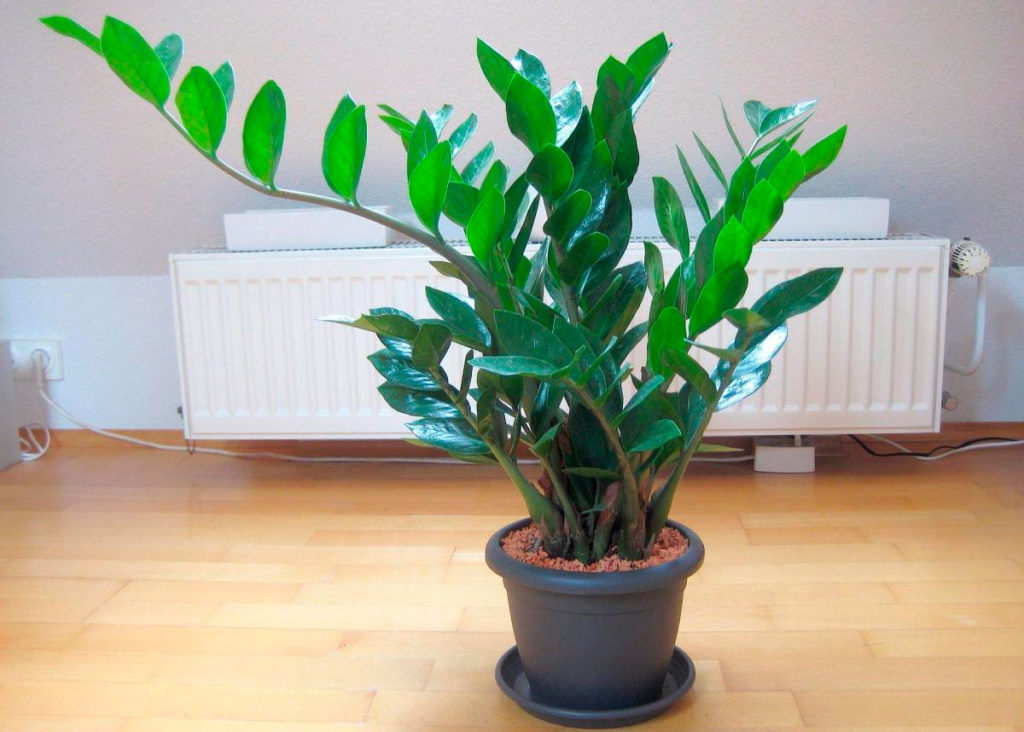
Content
General characteristics of the plant
Zamioculcas is a representative of the Aroid family, which was originally brought to Europe from the African tropics. This plant has massive leaves and a thick rhizome. It belongs to succulents, that is, the species that is able to survive significant droughts, due to its ability to accumulate moisture in the fleshy tissues.
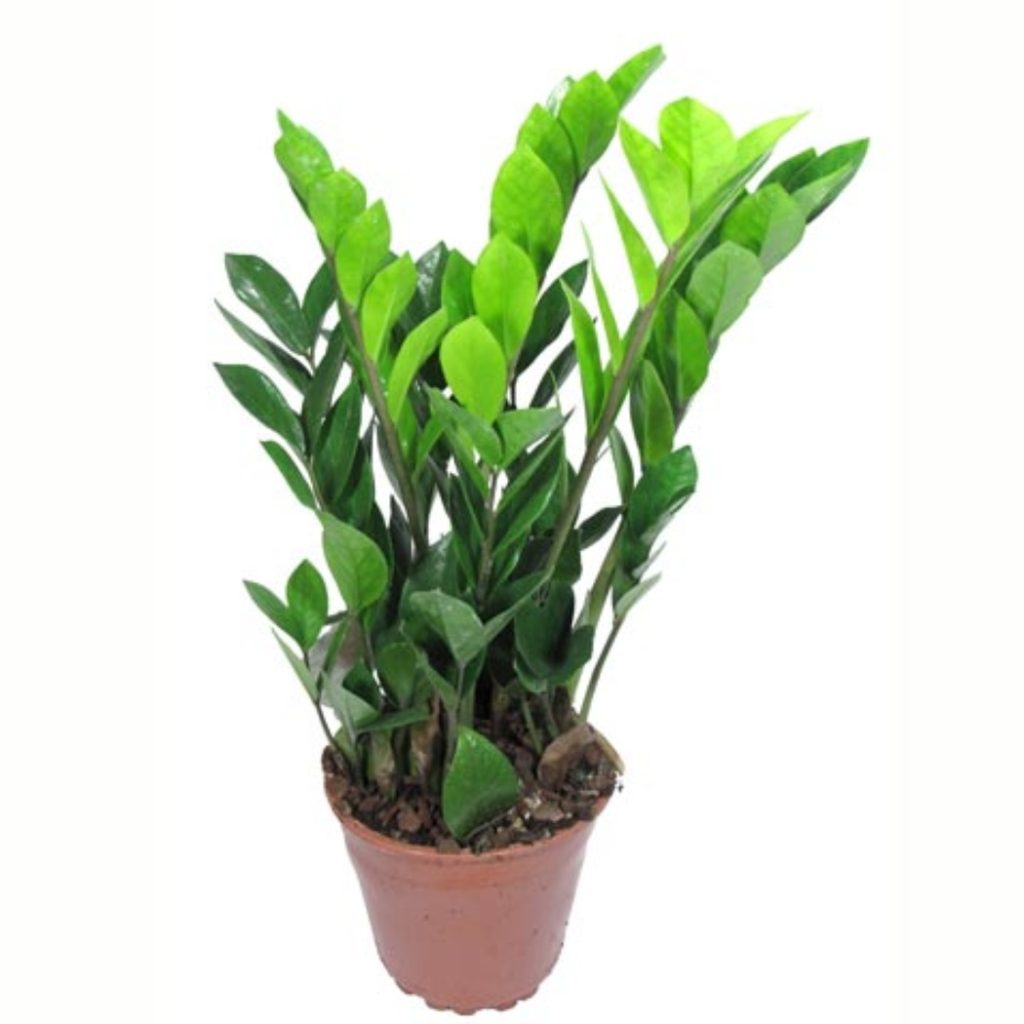
Based on this, it should be remembered that the flower has a number of features:
-
does not tolerate excessive watering;
-
requires a lot of sunlight.
Important! Zamioculcas is poisonous, so it can be dangerous for children and pets.When leaving, replanting and watering it is recommended to use gloves made of impervious material.
Flower propagation methods at home
Many experienced and novice florists are interested in how zamioculcas reproduces at home. There are a number of ways to reproduce this plant at home, which are very simple and do not require excessive effort.

Reproduction of zamiokulkas occurs in the following ways:
-
vegetative, that is, a method of propagation with the help of plant parts such as leaves, cuttings, shoots, and so on;
-
generative, that is, propagation by seeds.
Each of these methods has a number of advantages and disadvantages, and also requires compliance with special rules. Still, to propagate zamioculcas, as a rule, they use the vegetative method.
Video: methods of reproduction of zamiokulkas.
Vegetative ways
To propagate zamioculcas at home using such methods does not require much time and effort, the methods are usually simple.

Branch propagation
In the case of zamiokulkas, a branch is a leaf of a given plant. His leaves grow from the very base. Professional gardeners call the zamiokulkas branch a frond. The branch for propagation of zamiokulkas and for planting should be firm and coarse at the bottom, young and juicy at the top. There are several ways to root a frond.
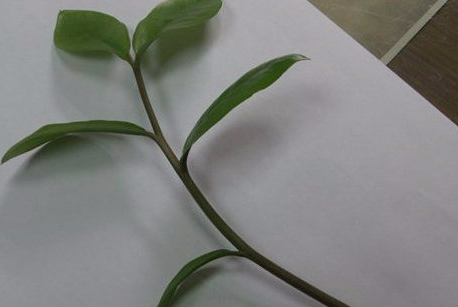
Planting fronds directly into the soil
In order to apply this simple method of propagation of a zamiokulkas by a branch for rooting, you must:
-
During the day, dry the frond rhizome, while wrapping the top in foil so that it does not dry out.
-
Before planting, lightly treat the base of the frond with a root fertilizer such as root.
-
Gently root a branch about the thickness of a phalanx in slightly damp soil.
Important! This method requires some experience and is not recommended for beginner growers, since the roots are less likely to develop under such conditions.
Rooting in water
Rooting in water has certain advantages, including the ability to control root development. To root a sprig of zamiokulkas, you must do the following:
-
stand water from the tap for a day;
-
add an activated carbon tablet to a glass of water;
-
put the vayu in a glass;
-
wait for the appearance of small roots;
-
root the branch in semi-dry soil approximately to the depth of the phalanx;
-
do not moisten the soil for two to three days.
By the way! Since with this method of rooting, the zamiokulkas branch absorbs a lot of water, it is necessary to water the vayu rooted in the ground very sparingly, otherwise the plant will rot.
Propagation by cuttings
The stalk is part of a branch with paired leaves. To breed zamiokulkas by cuttings, it is necessary to choose healthy cuttings without damage, having a fresh green color, without spots. Cuttings that are too old or immature are less likely to survive as they require a lot of nutrients to root.
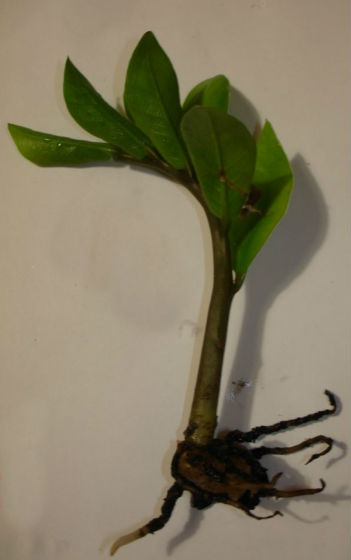
Stages of work on this method of rooting:
-
cut the shoot with a sharp disinfected razor;
-
dry the cutting during the day;
-
treat the base with the "root" preparation;
-
root in a glass with a drainage hole;
-
cover a young flower with a jar or film at night to create a greenhouse.
Important! The greenhouse should not be left in the open sun, as the resulting condensation will contribute to decay of the planting material.
The most favorable place for the development of a young plant will be a fairly bright corner, where there is no darkening and direct sunlight.
Note! Rooting of cuttings can be carried out in spring or autumn, when the plant has a growing season.
Video: reproduction of zamiokulkas by cuttings.
Growing from a leaf
Among the advantages of reproduction of a zamiokulkas leaf include accessibility and simplicity.A young fresh leaf without spots and damage is chosen as the planting material. The soil in this case should be light, contain a little sand for lightness and looseness. Suitable earth for succulents or vermiculite-sand mixture.
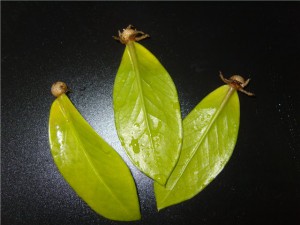
How to grow a zamioculcas from a leaf? To do this, you need to rooting the leaf as follows:
-
for about two hours the leaf is kept in the air to dry the base;
-
powdered activated carbon is applied to the base;
-
deepen the leaf of the zamiokulkas into a cup with soil at a distance of the phalanx.
Important! The planting material does not need to be watered for the first week. It should be lightly sprayed every other day.
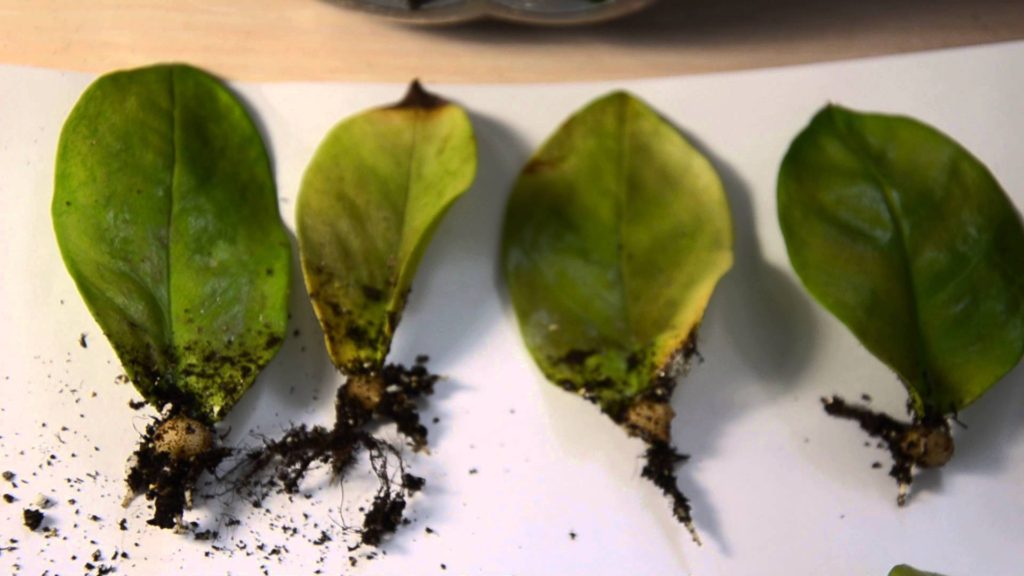
Growing a zamiokulkas from a leaf is a simple, affordable and convenient process. But this method has a significant disadvantage. The fact is that the cutting of zamiokulkas with leaves is a long process, that is, too long a process of development of a new plant.
Video: reproduction of zamiokulkas by a leaf.
Stem propagation
This is a very rare method because you need to know exactly how many leaves to remove from the base of the stem. It is necessary to remove them, because they can rot when in contact with the ground. If too many leaves are removed, the new plant will not be able to develop.
To root the zamioculcas with a stem, you must perform the following steps:
-
remove leaves from the base of the stem so as to free the stem from them by about ten centimeters;
-
leave the stem for a day in order to dry it;
-
powder the base with activated carbon;
-
slightly cut the base of the stem;
-
lay the stem in the substrate at an angle of about twenty degrees;
-
lightly sprinkle the base with earth.
Note! All cuts, cutting off plant parts must be done exclusively with a disinfected knife, otherwise infection and disease of the planting material is possible.
Tuber propagation
Reproduction of zamiokulkas tuber has the advantage that it allows you to grow a very strong and sturdy plant, which very soon will have the appearance of an adult flower.
In order to divide the tubers, it is necessary to take an adult zamiokulkas, which is at least a year old. The procedure should be carried out during the warm season.
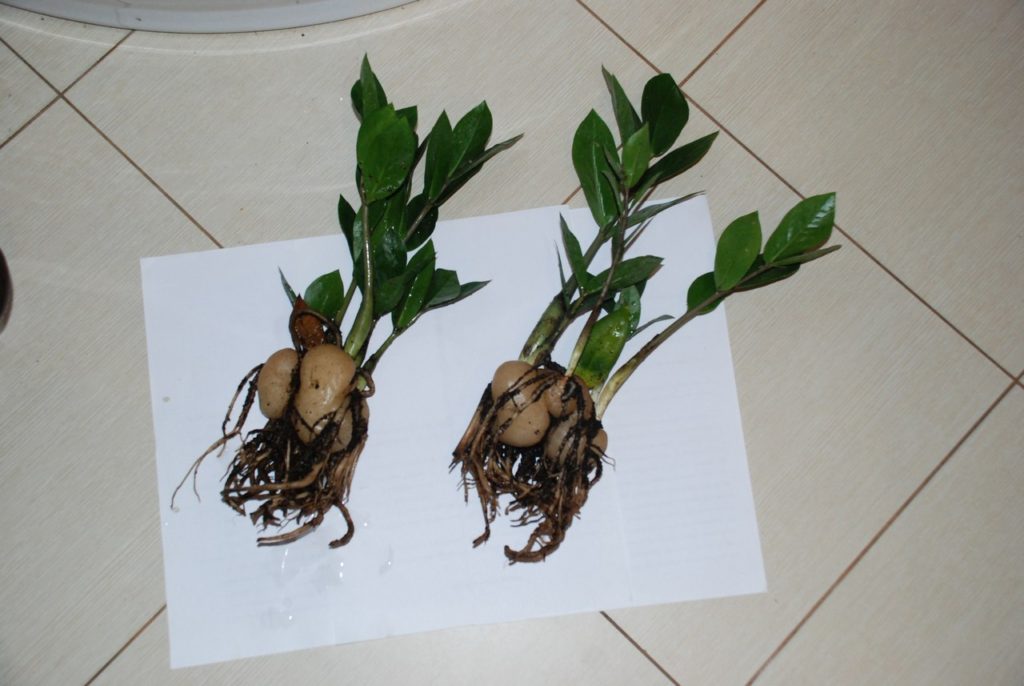
Important! If the tuber is inaccurately divided, there are very high chances of losing both the donor and the new plant.

Reproduction of zamiokulkas tuber includes the following steps:
-
careful extraction of the root from the container (it is important not to damage the roots);
-
washing the tuber;
-
separation of roots by untangling;
-
treatment of all damage caused to tubers with a weak solution of potassium permanganate;
-
drying the tuber for one to two days;
-
planting tubers.

With this method of rooting, the choice of substrate is important. An ideal root growing medium includes:
-
turf;
-
leafy ground;
-
sand;
-
peat crumb;
-
a small amount of humus.
At the same time, it is necessary to remember about drainage, which will not allow moisture to stagnate in the soil.
Generative reproduction
This method is rather complicated and is rather suitable for professional flower growers, since it involves the extraction of seeds from a ripe flower.
Seed propagation
Reproduction of zamiokulkas by seeds at home is a very troublesome and almost impossible task at home. The problem is that the flowering of this plant in a city apartment is quite rare. Those who have seen the zamiokulkas flower, as a rule, remain disappointed - it is inconspicuous and resembles an ear of corn.

Worth knowing! The flowering of this plant means that its life cycle is coming to an end, and it is likely to die soon.
Since there are a number of simple vegetative methods, professional growers prefer them.
Reproduction of zamiokulkas seeds at home, as a rule, is carried out for scientific purposes, following the steps below:
-
the flower is pollinated with a brush at intervals of about two hours;
-
after the formation of the ovary, watering is stopped;
-
after the formation and opening of the box, it is cut off and left for two days to dry;
-
the seeds are removed from the box by gently tapping it with your fingers;
-
the seeds are mixed with sand and sown in a vermiculite-sand mixture.
In such conditions, a system of artificial maintenance of the required temperature and humidity level is required. Under favorable conditions, seedlings grow from the seeds, which are divided after the small plants form two or three leaves.
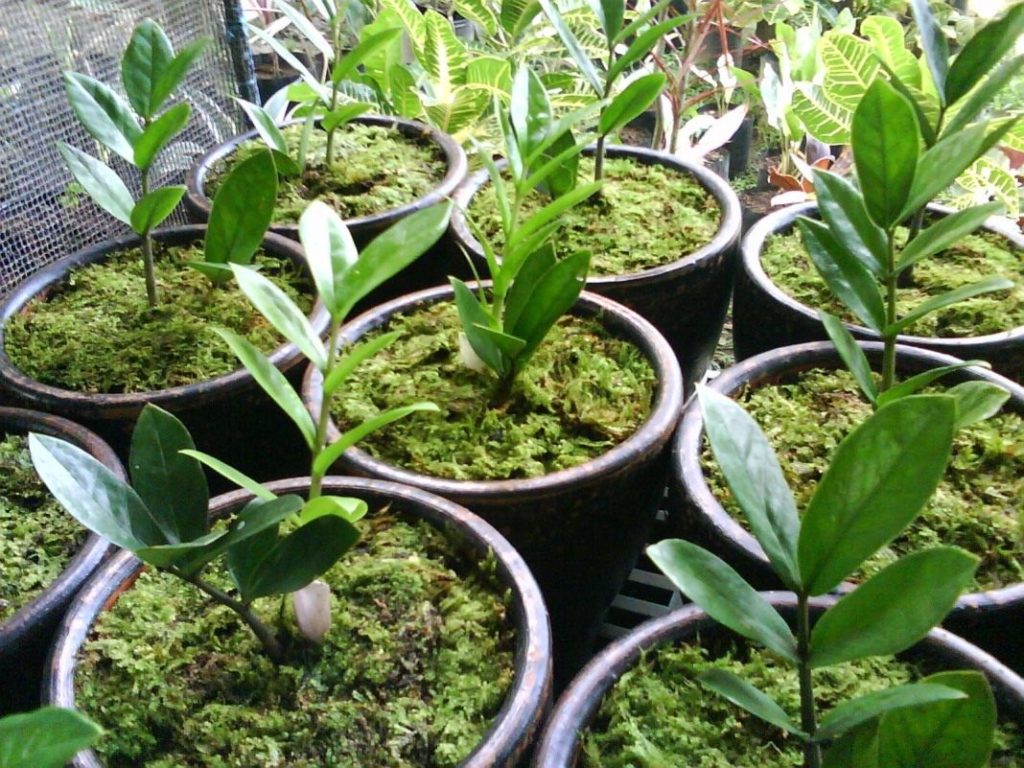
Possible problems
Reproduction of zamiokulkas, as a rule, is unsuccessful in a number of cases when flower growers make typical mistakes.
-
Not sterile cuts, neglect of disinfection. Since this plant is a succulent, a lot of moisture accumulates in its tissues, which, in turn, creates a favorable environment for the development of pathogenic microflora. Sterile cutting tools and new seedling containers should be used.
-
Damage to the planting material. This error is typical when dividing a tuber, when instead of untangling the roots, they are cut.

With strict adherence to the instructions and the elimination of possible errors, almost any non-professional florist is able to grow zamiokulkas on his own.

